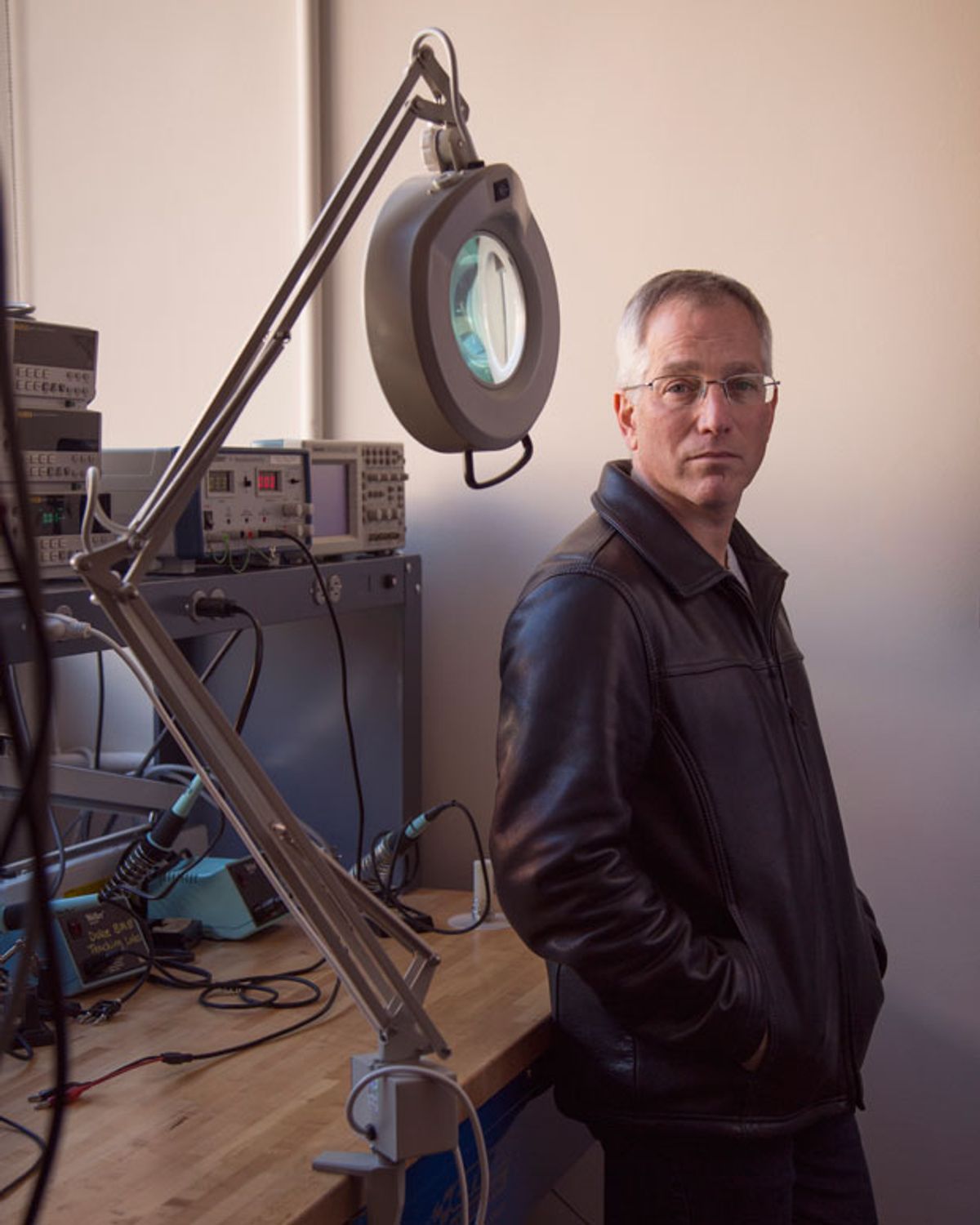Robert Malkin: MacGyvering Medical Gear
He is inspiring students to tackle urgent problems in the developing world

It’s 1989. Five years after earning his bachelor’s degree in electrical engineering, Robert Malkin is designing cardiac pacemakers in Switzerland. It’s an important job, and he’s developing deep expertise and earning good money. But he’s unhappy. Very unhappy. “I decided I didn’t want to be an engineer,” he says. “Actually, I didn’t want to work anymore, period. I had a party, burned my time card, and disappeared into the sunset.”
Disappeared into the sunrise is more like it. Malkin headed southeast to Thailand, where he signed up with a YMCA-sponsored team that was trying to get poor Thai parents to stop selling their daughters into that country’s booming sex trade. “It was more or less sexual slavery,” says Malkin. “Despite being immoral and illegal, it was happening in large numbers.”
The group Malkin joined had a simple strategy: to give vulnerable girls some skills that would make them too valuable to sell off. His job was to teach the girls English so they could help customize and peddle the handicrafts the villagers were making for tourists.
Video: Duke University
In one village his team visited, the local product was blue Mao shirts. The dye process required soaking the shirts for four or five days. Another volunteer showed them that by regulating the temperature, they could shorten the dyeing to just 45 minutes, recalls Malkin.
“That guy knew a really small tidbit of information,” he says, yet it was enough to change the economic calculus. “Overnight that village stopped selling their girls into prostitution.” The episode taught him that a tad of clever engineering can sometimes make an enormous difference in people’s lives.
Malkin then got a good offer to return to the United States and enroll in graduate school at Duke University, in Durham, N.C. His plan was to get a Ph.D. and head back to the mountains of Thailand.
He soon earned master’s and doctoral degrees in electrical engineering, specializing in a biomedical application aligned with his earlier work in Switzerland: cardiac electrophysiology. But he didn’t go back to Thailand. Instead, he got married, started a family, and took up faculty appointments, first at City College and Columbia University in New York City and then at the University of Memphis and the University of Tennessee. In Tennessee he was granted tenure and later became a full professor. Memories of Thailand faded—but they held a grip on him.
Robert Malkin
IEEE Senior Member
Age: 52
Occupation: Biomedical engineer,
Duke University
Location: Durham,
N.C.
Hero Moment: He left a tenured professorship to work on health-care challenges in the developing world.
Malkin knew that his academic research might improve some people’s lives, but not in the direct way he had witnessed in Thailand. He and a likeminded engineering colleague, Mohammad Kiani, often discussed their frustration. “We had both spent time in the developing world and realized that engineers had a unique opportunity to make a difference,” says Malkin. But how exactly?
They approached William Novick, a surgeon with the Memphis-based International Children’s Heart Foundation, and asked his advice. He suggested they join one of the teams of cardiac surgeons that the foundation sent to developing-world hospitals. The engineers could presumably help out if a piece of equipment malfunctioned.
“The very first day of the very first trip, the heart-lung machine broke,” recalls Malkin. “The surge protector had blown out—it was a 5-minute fix.” For an electrical engineer, that is. Most surgeons and nurses wouldn’t know how.
Malkin still had many free hours to explore other parts of the Nicaraguan hospital where the team was stationed. And he discovered a lot of defunct equipment. Kiani found the same to be true in the hospitals he visited. Realizing that their university back in Tennessee was retiring a great deal of surplus medical gear, they arranged to have some of it donated. And many of their students asked to participate in this informal foreign-aid program.
“We collected university equipment and formed a club to fix it and prepare it for shipping,” says Malkin. “Very soon we started getting calls from hospitals throughout the developing world.” So they began sending these facilities both equipment and engineering students to help keep things working.
His university grew uneasy with the legal liabilities this activity created, though. So Malkin, Kiani, and a business partner set up a not-for-profit company called Engineering World Health. Even then, Malkin’s department chairman wasn’t pleased. He wanted to see Malkin remain focused on academic research and grant seeking.
“It created a huge tension,” says Malkin. “So I left.”
In 2004, he walked away from an endowed full professorship to do work he thought was more important. It meant taking a non-tenure-track faculty position in biomedical engineering at his alma mater Duke, where he remains. Ironically, the programs he has spearheaded there have attracted more funding than his academic research had in Tennessee. And Malkin is a lot happier.
He’s writing fewer applications for research grants and teaching more, which he has long felt to be his true calling. He’s also been able to get his students directly engaged with the health-care problems of the developing world. In 2009, he launched the Global Public Service Academies, which arranges for high school students to volunteer at clinics and hospitals in Central America. And in the course of redirecting his career, something happened that surpassed even his most optimistic expectations: The engineering students he was educating about health-care problems in the developing world actually started solving some of them.
One of the issues underfunded hospitals face is that some equipment is so old you can no longer ensure that it works properly. Malkin recalls, for example, struggling with an antiquated defibrillator. “The only way to test it was to wait until a patient needed it—or to test it on myself and hope that it didn’t kill me,” he quips. A student solved the problem by designing a testing device. Other students at Engineering World Health chapters around the country began building the defibrillator testers, and some students took the devices with them to hospitals in the developing world. Eventually, thousands of students got involved, and the exercise taught Malkin something valuable about what motivates young people. “If I…lecture them about what a capacitor is, it’s a dry topic,” he explains. “But when you say, ‘You’re going to build a capacitor into this piece of equipment, and you’re going to save lives,’ that has great power.”
That same dynamic has played out with other student-designed equipment, including battery-operated lights to treat newborns suffering hyperbilirubinemia, a common form of jaundice, and special packaging for antiretroviral drugs that can help pregnant women with HIV avoid passing the virus to their babies. Getting this equipment into the right hands remains an economic and logistical challenge, but Malkin and his colleagues have come up with creative solutions, including setting up not-for-profit companies to sell the products cheaply to facilities in need.
“He’s woven this into the fabric of his profession—and his life,” says Kiani, now at Temple University, in Philadelphia. And by doing so, Malkin gets to revel every day in the realization that so moved him as a young man in Thailand: that a little engineering know-how, applied to the right problems, can do an enormous amount of good.
This article originally appeared in print as “Medical MacGyver.”
